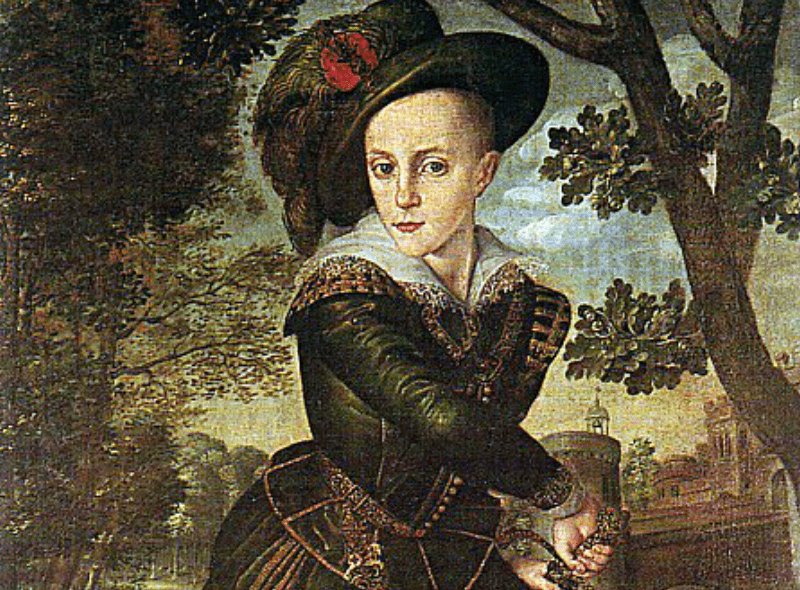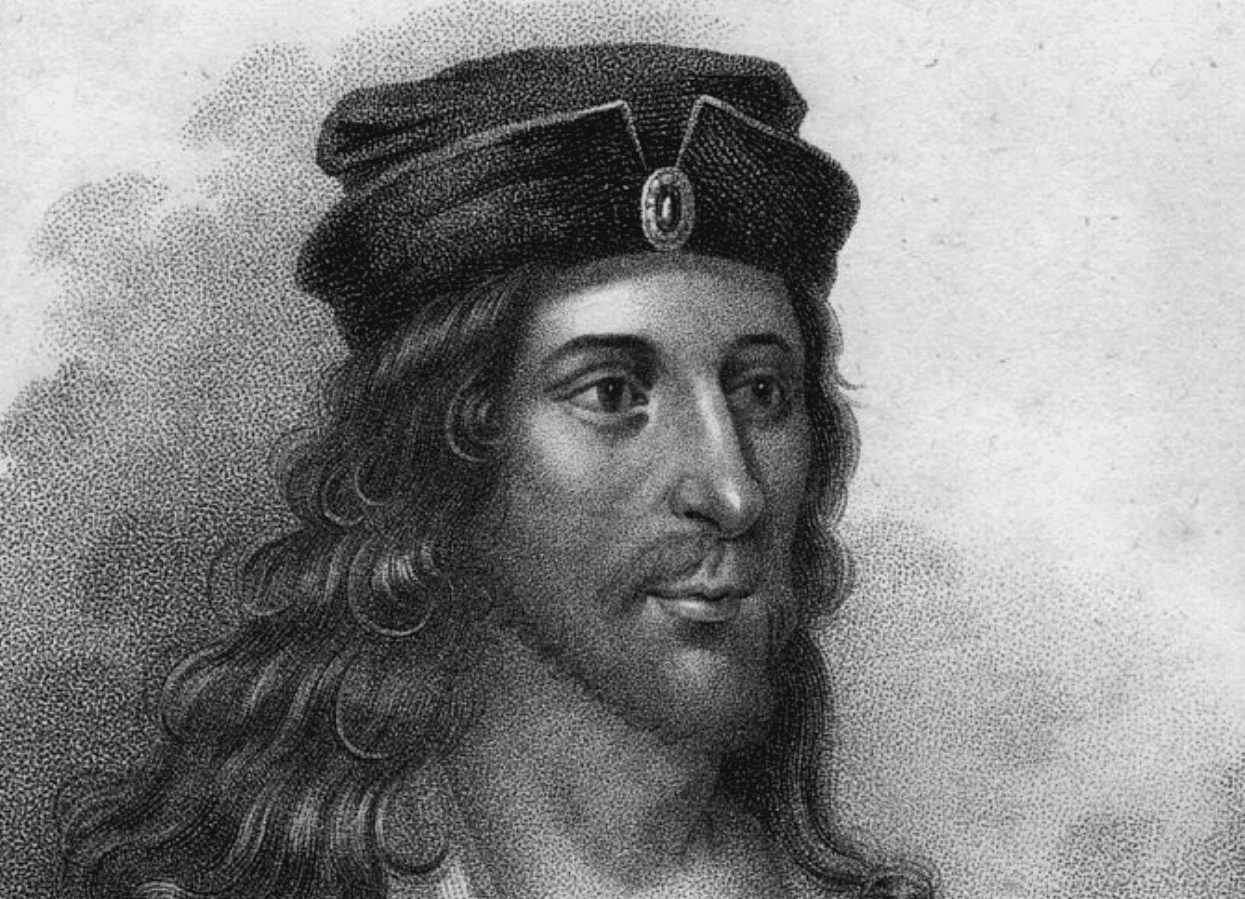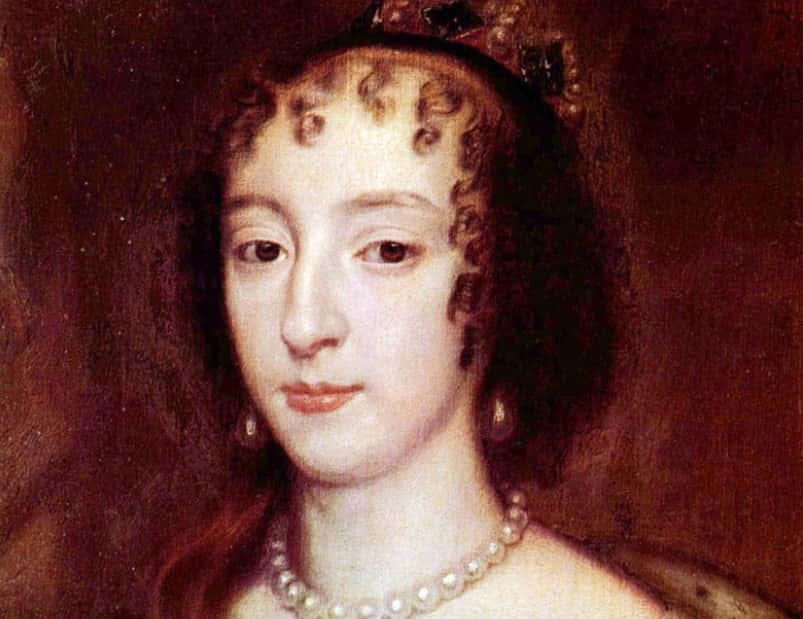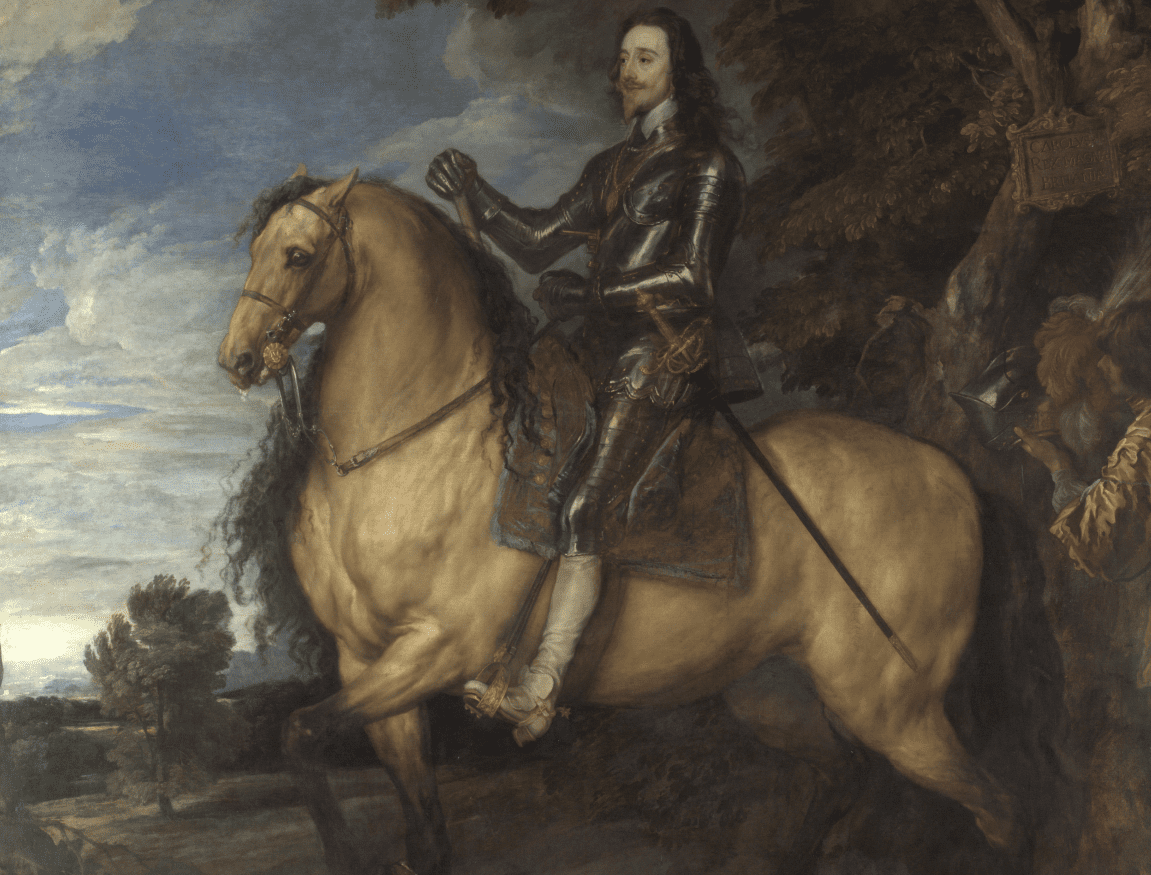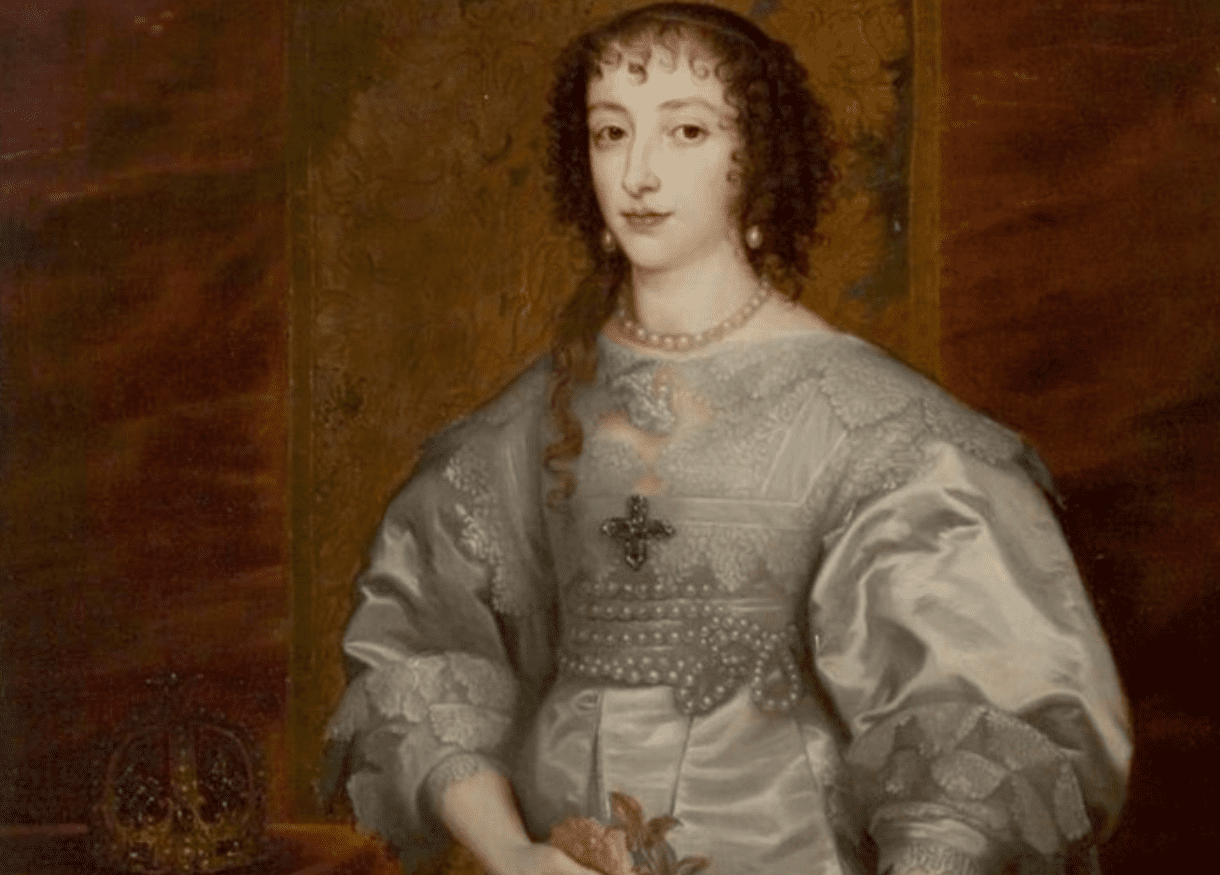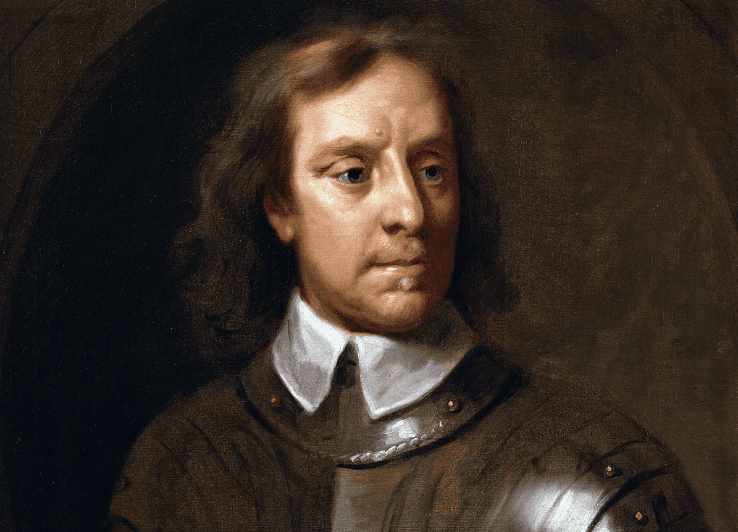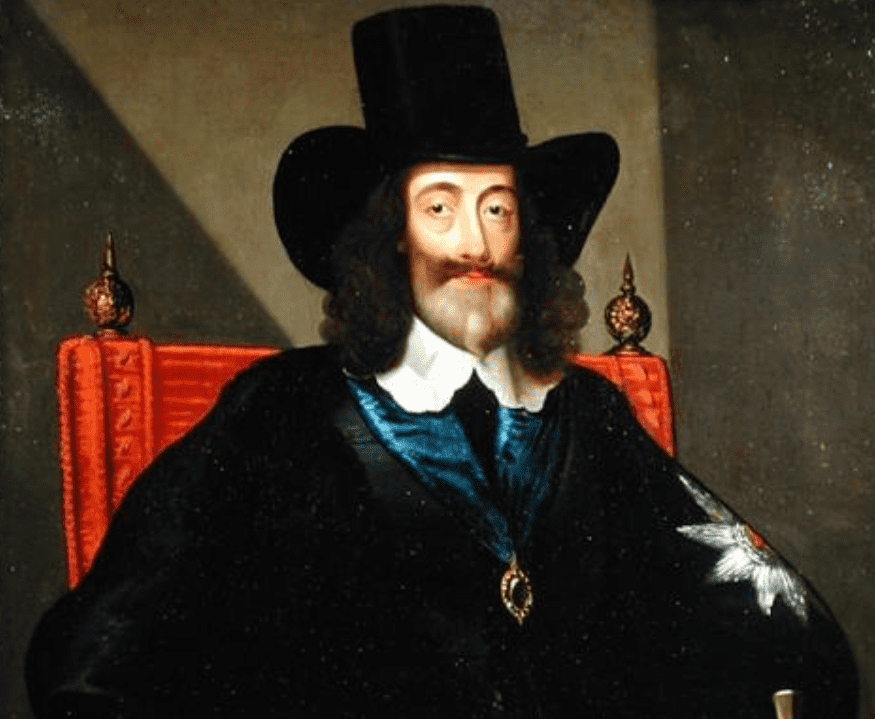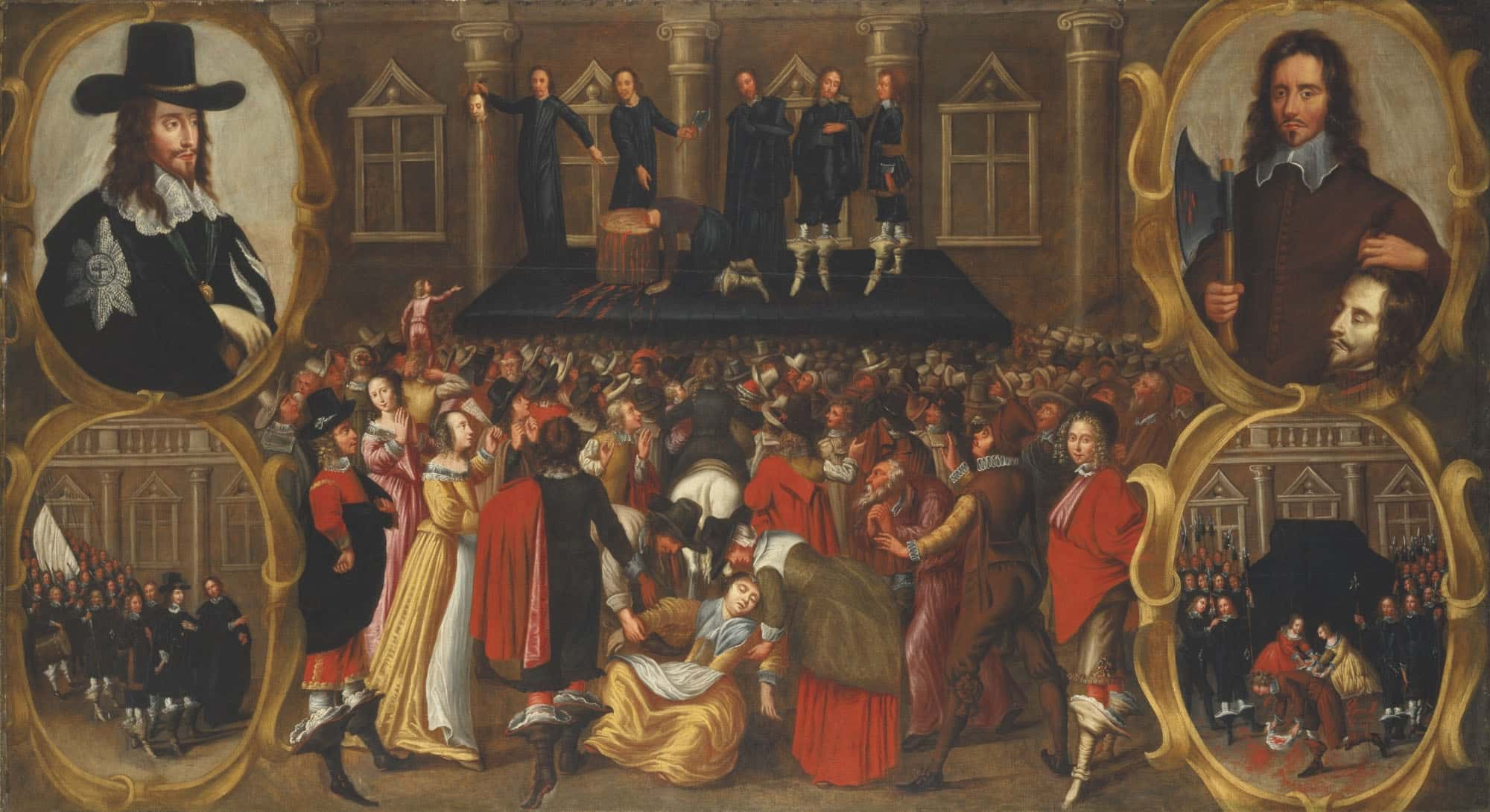When the executioner raised King Charles I’s head before the crowd of onlookers, they let out a moan unlike anything the country had ever heard, before or since. The King of England had been slain by his own people. How did Charles I go from an absolute monarch to a head lying at the foot of the chopping block? What went wrong? Dive into the dark history of Charles I, the doomed king.
1. He Never Should Have Been King
Charles was born into an uneasy family. His father, James VI of Scotland, and his mother, Anne of Denmark, had a chilly relationship, and they lived apart for most of their relationship. He was born the second son of the King of Scotland, never meant to see any throne. But as you’ll see, fate had other plans for this child.

2. He Was A Feeble Child
Charles' father became King James I of England when his cousin, Queen Elizabeth I died childless. Charles’ family was moving up in the world, but it came at a terrible cost for the poor boy. The entire family moved south to England to claim the crown—all of them except for one. Charles was a weak and sickly child, and his family believed he wouldn't survive the journey, so they left him behind in Scotland.
It wasn't until a year later, when a three-year-old Charles could walk the length of the Great Hall under his own power, that the family finally decided he was strong enough to join his family in England.
3. He Had a Terrible Speech Impediment
Weakness was just one of young Charles' problems. He was severely behind in speech development, and even when the words came, he suffered from a crippling stutter. He kept his stammer even into his adult life—something that his countless enemies were quick to use against him.
4. He Grew Into Himself
As he grew into a young man, the once frail Charles slowly became a little more robust and outgoing. He became skilled marksman and horseman, and even took up fencing in his spare time. Yet even as he came into himself, he was always stuck in another's shadow...
5. He Loved His Older Brother...
Charles's older brother Henry was everything that the young prince wasn't. Henry Frederick, Prince of Wales was a tall and burly young man, and the people of England adored him—barely anyone spared a second thought for little Charles. Charles himself looked up to his brother and tried to emulate him however he could...but there was a dark side to their relationship.
 Wikimedia Commons
Wikimedia Commons
6. ...But His Brother Didn't Love Him Back
The Prince of Wales didn't exactly reciprocate his younger brother's admiration. In fact, he actively detested his sibling, and would even publically humiliate the young boy. On one occasion, in front of a crowd of onlookers, Henry spitefully told Charles that when he was king, he'd make Charles the Archbishop of Canterbury—just so the robes could hide Charles's scrawny legs.
The onlookers laughed at the young boy, who had to be dragged away in tears.
7. His Brother Even Challenged the King
Henry was something of a bad boy, but the people still loved him. In fact, they liked him so much that he soon became a threat to his father's rule. The relationship between father and son was already tense, and things only got worse when Henry started openly defying King James in public. On one occasion, Henry even moved to strike James with a cane for criticizing him.
The uneasy relationship between father and son seemed like it was turning into a major problem—but a sudden tragedy soon changed everything.
8. A Loss in the Family
To everyone who saw him, the Prince of Wales seemed like a picture of health—which only made it more shocking when a sudden illness took his life at just 18 years old. The nation reeled, and thousands came to his funeral to pay respects. Leading the mourners was young Charles who, despite his rocky relationship with his brother, was still devastated by the loss.
There was, however, one extremely noticeable absence from the funeral proceedings.
9. A Fear of Funerals...or Something Darker?
King James I, Henry's own father, refused to attend the Prince's funeral. Now, the king famously hated funerals, so this wasn't completely unheard of, but based on their relationship, it's hard to imagine that's the only reason James didn't show. It's too bad, too, because if he'd attended, he would have seen quite the show...
In a bizarre twist, a madman interrupted Henry's funeral, running completely undressed through the church claiming to be the departed prince come back to life.

History's most fascinating stories and darkest secrets, delivered to your inbox daily.
10. The Deaths Don't Stop
After Henry's demise, Charles became the heir apparent, but he would have to face even more tragedy before he finally made his way to the throne. A few years after his brother passed, Charles's mother, Anne of Denmark, fell gravely ill as well. To make matters worse, King James rarely visited her during this period—but Anne was not alone in her final weeks.
Throughout Anne of Denmark's dying days, young Charles slept in the bedroom next to hers, rarely leaving her side. He was there right next to her when she finally passed on.
11. The Favorite
King James wasn't there for his wife in her final days—probably because he had other relationships to take care of. The Duke of Buckingham was one of the king's favorites, and he became a tremendous influence in court. But as the Duke gained more and more power, rumors swirled that the king's relationship with the dashing Buckingham was a little more than friendly...
12. Love Makes Us Blind
The king's letters to the Duke of Buckingham reveal that their relationship was something than cordial. He refers to the Duke as his "sweet child and wife," and himself as the Duke's "dear father and husband". What's more, by all accounts, Buckingham reciprocated James's feelings. In his own letter to the king, he wrote, "I naturally so love your person, and adore all your other parts, which are more than ever one man had," and "I will live and die a lover of you".
No matter what the exact nature of their relationship, it allowed Buckingham quickly rise through the ranks in James's court—and that's where the trouble started...
13. We All Know Someone With a Useless Boyfriend
Through his relationship with the king, the Duke of Buckingham rose to the rank of Lord Admiral, effectively becoming England's foreign minister. There was only one problem...he was absolutely terrible at it. He constantly fumbled combat expeditions, wasting money and men on doomed exercises. On one occasion, his sent several ships of poorly trained and under-equipped men to France to raid the shoreline...but they only made it as far as a warehouse full of wine. At that point, they simply got tipsy, and Buckingham had to call off the entire plan. Does that sound like a success to you?
 Picryl
Picryl
14. Sending Your Sidepiece to Find Your Son a Wife
It seemed as though the Duke of Buckingham screwed up everything he touched, yet King James insisted on relying on him. That's why, in 1623, he sent Buckingham, along with Charles, to Spain in order to find the heir to the throne a wife. It seems like a pretty simple task—but it ended in utter disaster.
15. The Trip to Spain did not go as Planned
Tensions between Catholics and Protestants were at an all-time high. King James hoped to ease the divide by marrying his Protestant son to the Catholic Maria Anna of Spain. Simple, right? Not exactly...When Charles and Buckingham arrived in Spain, King Philip IV suddenly had a new set of demands. If Charles was to marry his daughter, Philip demanded that he not only convert to Catholicism, but that he stay in Spain for an entire year to make sure that it stuck.
Charles was absolutely furious that the Spanish King had changed the terms of the deal, and the trip meant to forge ties between the two countries ended up having the opposite effect. When Charles and Buckingham returned to England, they forced the king to raise arms against Spain instead.
16. The King's Body was Falling Apart
Charles and Buckingham forced King James into a conflict he didn't exactly want—but he wouldn't have to deal with it for long. By this point, he suffered from crippling arthritis and gout, and according to his doctor, his urine was "the dark red color of Alicante wine". James took to drinking to ease his pain, and soon all of his teeth had fallen out. The king was not long for this world—but even still, the end was absolutely gruesome.
17. The King is Dead, Long Live the King
After a long, painful illness, King James finally perished after a particularly horrible bout of dysentery. Of course, his beloved Duke of Buckingham was there by his side when he took his last breath. By this point, Buckingham and Charles had essentially taken control of the kingdom already, but now it was official. Charles became King Charles I of England. He inherited a country in total turmoil—and it was only about to get worse.
18. I Take You as My Husband...Well, Not Really You...
In a rare light spot in Charles I's reign, he finally managed to find a bride in May 1625, shortly after his father passed on. He married the beautiful Henrietta Maria of France in front of Notre Dame Cathedral—but their wedding wasn't exactly romantic. Charles wasn't actually there for it. In fact, the couple hadn't even officially met! Since Charles was still in England, a proxy stood in for him at the wedding.
The husband and wife finally met face to face months later, after Henrietta arrived in England.
19. We Do Not Approve
Charles finally had a bride—but somehow, it only managed to make things worse. The House of Commons was furious that Charles had married a Catholic. They made Charles promise that just because he had married a Catholic, he wouldn't ease up on Catholics in England. Charles swore that nothing was going to change—but what the House didn't know was that he was lying through his teeth.
In secret, Charles had not only promised the King of France that he would ease restrictions on Catholics, but he also promised English ships to help Catholic France fight against Protestants.
20. The Hated Queen
The people of England absolutely hated Queen Henrietta Maria. Not only was she a Catholic, but she didn't even speak English! She didn't help matters in 1624, when her husband was finally crowned and she refused to take part in the Anglican ceremony. She watched from a distance—so she was there to see the crowds turn ugly as they realized that their Queen refused to accept her crown with their king.
21. I Don’t Have to Listen to This, I’m a God!!!
Charles's father, James I, firmly believed in the Divine Right of Kings. He described monarchs as "little gods on Earth" who could, essentially, do whatever they wanted—and Charles felt the exact same way. This put him above the law and above the need to explain himself. Of course, this belief didn’t do him any favors down the line—but more on that later.
22. Charles Got Off to a Bad Start
The start of Charles's reign was a complete PR disaster. Not only did his French, Catholic Queen refused to be crowned, but he continued to rely on his father's beloved, the Duke of Buckingham, for everything. The same Duke whose guts the House of Commons hated and who managed to screw up just about everything he touched.
After yet another failed army expedition by Buckingham, the House moved to impeach him once and for all—and that's when things started to get really ugly.
23. Throwing His Weight Around
When Parliament moved to impeach Buckingham, Charles did the unthinkable—he ordered his guards to arrest two of the members who'd begun the proceedings. The two politicians were thrown in a cell for rightfully pointing out that Buckingham was a miserable failure and maybe shouldn't be running the country. That Charles would arrest two of their own members in such an obvious misuse of power absolutely scandalized the entire House of Commons—but was Charles did next was far worse.
24. Pardon Me, Parliament
Charles couldn't come up with any real offense with which to charge the two men whom he'd apprehended, so he let them go—but that didn't mean he was finished. The House continued to call for Buckingham to go, so Charles went one step further. He dismissed Parliament completely. He wanted to make one thing abundantly clear: This was his country, and he was going to do what he wanted. Little did he know, he would come to pay a terrible price for his arrogance.
25. So Much for Marital Bliss
As if things weren't going bad enough for Charles in the Parliament, things were even worse at home. Henrietta Maria was an extremely strong-willed person, and the two of them fought constantly in the early years of their relationship. Eventually, their fighting got so bad that Charles decided to try and teach his wife a lesson. He expelled everyone single one of her French attendants from England. Henrietta Maria, who barely spoke a word of English herself, ended up completely isolated in a country in turmoil.
26. The Finger Thing Means Taxes
While he wasn't busy making his wife's life miserable, Charles was doing everything in his power to anger the rest of England. He was still trying to find money to fund his conflict with Spain, but since he had dismissed Parliament, there was no way for him to raise taxes. That wasn't about to stop Charles, though, and he ended up inventing some truly despicable ways to raise the money he needed.
27. What Could be Bad About a "Forced Loan"?
Charles scoured English law and found every single loophole he could to scrounge as much money as possible from his people. He found ancient, unused laws that allowed him to levy a "forced loan," and imprisoned anyone who didn't pay up without a trial. If the people hated him before this, they absolutely despised him now.
England was a powder keg—and it was only a matter of time before something set it off.
28. The Duke's Doom
In 1628, while drinking at a pub, an assassin fatally stabbed the Duke of Buckingham. The assailant, John Felton, was an army man who had been seriously wounded in one of the Duke's many failed army expeditions. When news of the slaying reached London, the crowds rejoiced. They hailed Felton as a conquering hero, and poets wrote ballads commending and justifying what he did.
But while the people celebrated, the king was utterly devastated.
29. My Heart is Breaking
Evidently, Charles loved Buckingham almost as much as his father did. When he heard the news of the Duke's demise, he burst into wild sobs and threw himself on his bed. One might have hoped that with Buckingham out of the picture, the relationship between Parliament and the king might finally improve—but instead, it only got worse. There was, however, one silver lining to Buckingham's passing...
30. Maybe He Was the Problem?
For whatever reason, the demise of Buckingham marked a turning point in Charles's marriage. He and Queen Henrietta Maria grew much closer during this time, and soon forged a deep and passionate bond for one another. They even became, dare I say, playful, and Henrietta became known for playing practical jokes on the king. As the cherry on top, the Queen even became pregnant for the first time—but even that would lead to tragedy.
31. At Last, a Son
Charles and Henrietta Maria's first child perished shortly after birth. The couple was heartbroken, but they tried again two years later. This time, after a harrowing labor, Henrietta Maria gave birth to a healthy son, the future Charles II of England. Charles had finally achieved a semblance of a happy family—but he would not be able to enjoy it for long.
32. Meeting Adjourned
Throughout all of this, Charles continued using outdated laws to scrounge every single penny he could from the English people. This led to one of the most bizarre scenes in the history of the English Parliament. In 1629, as dissent was brewing, Charles tried to end a meeting of the Parliament before anyone could speak against him. I'm sure he felt quite pleased with himself—but he never expected what happened next.
33. Hold Him Down!
The furious members of Parliament were not about to let Charles walk away scot-free, so they came up with a desperate plan. If the Speaker of the House remained seated, Parliament could not be dismissed, so several men physically held him in his chair while they said what they needed to say. They denounced Charles's shady tax schemes, and their declarations received cheers from the rest of the House.
Charles was utterly humiliated—and it led him to drastic action.
 Cromwell ,Columbia Pictures Corporation
Cromwell ,Columbia Pictures Corporation
34. A Tyrant is Born
The debacle in the House was the last straw for Charles. He imprisoned nine of Parliament's leading members and completely dissolved Parliament. He wouldn't call them again for the next eleven years. The king spent that time ruling England alone and with an iron fist, in what is now remembered as the Eleven Years' Tyranny. Charles was determined to rule England by his divine right alone, without the meddling of pesky politicians.
He didn't realize it at the time, but this action set in motion the events that would eventually lead to his downfall.
35. Don’t Mess With the Scots
Despite being born in Scotland and spending the first years of his life there, Charles didn’t return to the highlands until his coronation as King of Scotland in 1633. He ended up angering many Scots by insisting on an Anglican ceremony. Charles couldn't have cared less and went about his business anyway—but he would come to regret crossing them.
36. Time to Pay Up
At the time of the Eleven Years' Tyranny, Charles continued to come up with every underhanded scheme he could to get money. There was an ancient and completely forgotten law that required land-owning nobles to present themselves to be knighted at the new king's coronation. Despite the fact that no one had used this law in generations, and despite the fact that this was years after his coronation, Charles went ahead and fined anyone who hadn't shown up.
Needless to say, people were not happy about it.
37. A Strange Tax Haven
I don't really mean to defend Charles in all of his money-grubbing schemes, but there is something worth noting here: During Charles's reign, England was actually the least taxed country in Europe. Charles looked across the water to the continent and saw all the other kings rolling in it while he was left begging for scraps.
38. Fear the Scales of Justice
The courts become Charles's attack dog during Eleven Years' Tyranny. Under Charles, they censored anyone who spread opposing views, and their punishments could be utterly disturbing. In 1637, authorities caught three respected noblemen publishing religious pamphlets that the king didn't agree with.
In response, the courts had the three distinguished men publicly locked in the stocks, whipped, mutilated, then imprisoned indefinitely.
39. There Was a Terrible Price for Messing With the Queen
The Catholic Queen Henrietta Maria became a target of England's hatred during this period—and Charles's revenge against anyone who spoke against his wife was utterly chilling. He had one man whipped, branded, and mutilated for publishing a pamphlet critical of the queen. In another instance, a man wrote that "women actress were notorious whores," clearly a blatant stab at the Queen, who was an actress herself. Charles had the man's ears cut off for the insult.
40. All Good Things...
The Eleven Years' Tyranny came to an end thanks to Scottish bishops giving Charles a headache. Charles had stirred up the Church of Scotland by pushing The Book of Common Prayer on them in an act of reformation. In response, the Scottish Bishops’ Wars began, which eventually forced Charles to call for Parliament to be formed once again in 1640.
41. Never Again
By the time Charles finally called Parliament again, it was far too late to repair the relationship—his days were numbered. The House of Commons openly defied him at every turn. First, they closed the loophole that he’d used to shut them out for eleven years. Next, they passed acts declaring that Parliament couldn’t be dissolved without their consent and that England couldn’t go more than three years with a dissolved parliament. Well Charles, it was nice when it lasted.
42. I Guess Everyone Hated Charles
The final straw between Charles I and Parliament came during the Irish Uprising of 1641. The king and Parliament each had their own ideas on how the army should be used to restore peace in Ireland, and who should be given command of said forces. Eventually, Charles had enough of his many critics—and he came up with a plan to finally show Parliament that he was still the boss. It...didn't go so great..
43. Seize Them!
Charles hatched a scheme to personally arrest five high-ranking members of Parliament in the House itself, an absolutely unprecedented move. No English monarch had ever entered the House of Commons for any reason, let alone to unlawfully arrest its members. The plan was bad to begin with, but it still managed to turn into a total disaster.
44. Well That Went About as Badly as It Could Have
Word of Charles's plan reached the House before the King arrived, and the men who Charles wanted apprehended managed to flee before he even got there. His big plan failed spectacularly, but it was even worse than that. The only real defense that Charles's supporters could come up with was to appeal to tradition in the face of dangerous progressivism. As soon as Charles stepped into the House of Commons, he not only made a fool of himself, but he proved that he was just as radical as his enemies.
This was the last straw. Parliament took advantage of the situation and seized London for themselves. Charles was forced to flee north to Oxford and plan his next move. The First English Civil War was upon them.
 Public Domain Collections - GetArchive
Public Domain Collections - GetArchive
45. He Just Couldn't Do Anything Right
If Charles was bad at being a king in peacetime, he was even worse at being a king during war. At one battle, he foolishly tried to ride to the front lines to rally his men. His general wisely realized that sending the King of England to the front lines to be slain was a terrible idea, so he ended up grabbing the reins of Charles's horse and pulling him back.
Needless to say, this was not a good look. The king's forces thought this was a signal to retreat, so they turned and gave up the ground they'd gained, turning the battle into a decisive defeat.
46. Don't Mind Me...
It seemed as though everything was going wrong for Charles. His forces kept on losing battles, and the king himself was almost kidnapped during the Siege of Oxford—he only escaped by disguising himself as a servant and slipping away under cover of darkness. Charles was getting truly desperate, but still, no one expected what he did next.
47. I Surrender
With his army losing ground at every turn, Charles made an unbelievable decision: he gave himself up to the Scots. We should point out, these were the same Scots who had rebelled against him just a few years earlier. He figured that the Scots hated the English Government even more than they hated him, so he was probably safest with them. Turns out, Charles had just made the worst mistake he'd ever made in his life.
48. This Did NOT Go as I Expected
The Scots kept Charles their captive for nine long months as they negotiated ransom terms with the English Parliament. In the end, Parliament agreed to pay Scotland £100,000, with more down the line, to withdraw their armies and give up the king. Charles's gambit had completely failed, and he was about to step into the mouth of the beast—but he had one desperate plan left to try and save his own skin.
49. Careful Who You Trust
Charles saw the writing on the wall and realized it was finally time to retreat. He escaped his custody and tried to flee to a safe haven, maybe in Europe, where he could bide his time and plan his next move. However, he made a fatal mistake during his flight. He contacted Colonel Robert Hammond, a man who he thought he could trust. He was wrong.
As soon as the King made it to Hammond's custody, the colonel captured him and contacted Parliament. Charles had finally run out of time.
50. The Resistance Was a Total Mess
Queen Henrietta Maria left England for her own safety early in the civil conflict. As the king's hopes started looking worse and worse, more and more Royalist sympathizers fled to France to join the Queen. The hope was that they could raise a resistance to rescue Charles and defeat the Parliamentary forces—but things did not go as planned.
The Royalists seemingly couldn't agree on anything, and the Queen's court was beset with arguments and duels. Henrietta Maria herself had to personally stop men from drawing swords on multiple occasions. It was chaos—but it was nothing compared to what was happening back in England.
51. The Anti-King Rises
The civil conflict in England led to a seismic power shift in the country. While there were still some parliamentary voices who wanted to negotiate with the captive king, there was really only one voice who mattered by this point: Oliver Cromwell, leader of the New Model Army. Cromwell firmly believed that Charles was a bloody tyrant who would not be dealt with, and that was that.
The army apprehended any members of Parliament who dared challenge them and took control of England by force. It was a military coup—and it meant that absolutely nothing could save Charles now.
52. Whatchu Gon' Do With All That Rump?
Cromwell formed the Rump Parliament, and with them, indicted Charles on the charge of treason. However, despite the fact that pretty much everyone hated Charles by this point, this action made most people extremely uncomfortable. Sure, Charles had been a selfish tyrant, but he was still the king, and kings ruled by the Divine Right of God. Under that view, a king literally couldn't commit treason.
The House of Lords threw out the charges without even considering them. All of England's Chief Justices said the indictment was unlawful. But none of that was going to stop Oliver Cromwell from delivering his grim justice.
53. This Is Happening
The thing about an armed coup is, as long as you hold the bigger stick, you don't really have to listen to anyone. The Rump Parliament declared that it could, essentially, do whatever it wanted. The trial of King Charles I of England—the first and only such trial ever held on English soil—was coming.
54. Too Scared To Show Their Faces
The English Parliament had spent decades trying to foil Charles at every turn—but when the day of his trial finally came, the vast majority of them were nowhere to be found. Only a mere 68 members of Parliament dared show their face at the trial of the king, held on January 20, 1649, at Westminster Hall.
55. The Treasonous King
The court claimed that Charles had used his power for his own personal gain, and not in the greater interest of his kingdom. For this, they determined that he had committed treason against England, the punishment for which was death. For the first three days of the trial, the court tried to get Charles to respond to the charges, but every time they turned to him, he refused.
Charles held firm that no court had the right to challenge the divine right of a monarch—and he would take that to his grave.
56. Hostile Witness
Charles refused to answer to any of the charges, but that didn't stop the trial from moving forward. Eventually, Parliament had the king removed from the court, and proceeded to call witnesses for the next two full days, each of whom testified to the king's offenses. In the end, none of it really mattered. Cromwell and his cronies had already made up their minds.
On January 26, 1649, Charles I of England was condemned to die.
57. I Will Not Quake
The morning of Charles's execution was cold and windy. To prepare to meet his fate, Charles asked his attendants to prepare two shirts for him to wear. Why? He knew there would be a chill, and he didn't want to be shivering as he stepped up on the scaffold. He didn't want the crowd of onlookers to assume that he was scared to die.
58. We Can't Hear You
In his final moments, Charles gave an impassioned speech about how his execution was unlawful and how he had only ever ruled with the best interests of England in mind. However, the speech was in vain. In order to prevent anyone from interfering, Cromwell had ordered many battalions to stand between the scaffold and the crowds beyond. Charles was so far away that only the people actually on the scaffold with him heard his final pleas.
59. The Monarchy is Over
If nothing else, Charles met his fate with courage. After saying a short prayer, he willingly placed his head upon the block and signaled to the headsman that he was ready. The ax took off his royal head with one precise swing. According to one observer, when the ax landed, a moan "as I never heard before and desire I may never hear again" came from the crowd of onlookers.
60. Secret Identity
The headsman who swung the ax that felled the king wore a mask that day, and he never dared to speak a single word. Traditionally, when someone was beheaded for treason, the executioner would hold their head up to the crowd and cry, "Behold the head of a traitor!" While Charles's headsman did indeed hold the king's head aloft, he stayed completely silent. He didn't want anyone to know that he had been the one who had slain the king.
61. I Wonder Who Had That Job?
After Charles was executed, embalmers morbidly sewed his head back onto his body, prepared it for burial, then finally entombed it in a lead coffin.
62. There’s Blood on Those Paintings!
By the time of Charles I’s execution, he had acquired 1,760 paintings in one of the largest private art collections of the period. The majority of these paintings were sold off by the English Parliament in what must have been either the most prestigious yard sale ever or the most awkward auction ever held.
63. Taking Control of the Country
Once the king was executed, Oliver Cromwell set about extinguishing every last bit of dissent from the British Isles. His forces crushed all opposition—including from Charles's own son—until Cromwell was the last man standing. But it turned out that England had simply swapped out one tyrant for another. As soon as the Third English Civil War ended, Cromwell disbanded the Rump Parliament and took control of England himself as the Lord Protector.
64. On the Run
For a period of 40 days between the end of the conflict and his escape to France, Charles's son, the future Charles II of England, was a fugitive. Cromwell and his cronies hunted him through England, but Charles was fortunate to have the protection of a few loyal subjects who kept him out of Cromwell’s reach.
 Charles II: The Power & the Passion, BBC
Charles II: The Power & the Passion, BBC
65. England Went Out of the Frying Pan and Into the Fire
Cromwell despised the monarchy and did everything in his power to ensure it went to the grave with Charles I—but he ended up turning into the exact thing he hated. He ruled England with an iron fist for nearly a decade, then, even worse, when he perished, he passed the Protectorate onto his son! Not only was his son a weak and ineffective ruler, passing the reins to your son was exactly what kings did.
Many people in England had spent decades fighting to destroy the monarchy, and when they finally managed it, they realized they had created something even worse.
 Cromwell ,Columbia Pictures Corporation
Cromwell ,Columbia Pictures Corporation
66. Let's Just Pretend This Whole Thing Never Happened
Richard Cromwell was a poor imitation of his father, and he barely held onto England for two years. The Parliament came back, and in 1660, after years in exile, Charles I's son returned to claim what was his. He was crowned King Charles II, and just like that, things started to go back to the way they were—though no king would ever again have as much power as the doomed Charles I wielded.
67. What Was Taken Can Be Given Back
The army was the one who pulled Charles I off the throne—and they were the ones who put Charles II back on it! After the pathetic rule of Richard Cromwell, the army personally invited Charles II to return from France and reclaim the throne.
 Charles II: The Power & the Passion, BBC
Charles II: The Power & the Passion, BBC
68. A Barrel of Fun
Ironically, Oliver Cromwell actually made the people of England love the monarchy! Charles II was known as the Merry Monarch for being in direct contrast to the previous era of Puritan rule. He was known for his high-living and excessive ways and was generally appreciated for his dynamic spirit.
69. A Heartbreaking Farewell
When the time came for Charles’ execution, his wife and most of his children had long since fled England and weren’t able or willing to return for a final goodbye. However, in the moments before his end, he did have a heartbreaking farewell with two of his children, Henry and Elizabeth, who were being held by the new authorities. They were permitted to visit their father for a tearful goodbye just a day before Charles’ execution took place.
70. Remember This Day
The execution of Charles I was something that England had never seen before and would never see again. As such, some of the crowd rushed the scaffold to take a gruesome memento from that infamous day. Many onlookers dipped their handkerchief in the king's blood, a stain that would forever mark the day that England executed its own king.






